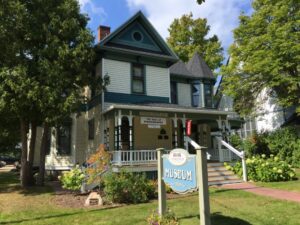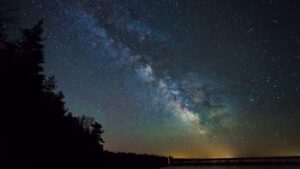
Historic Mill Creek
Historic Mill Creek has 625 acres along Lake Huron, 3.5 miles of hiking trails, a reconstructed saw mill, mill dam, and more.
Photo by the Harbor Springs Historical Society
Northern Michigan is home to several museums dedicated to preserving the area’s rich history and give a look into the array of industries — both past and present. Take a step back in time to learn about the history of Northern Michigan communities and culture through digital story telling, authentic images and artifacts, as well as engaging interactive exhibits to engage and captivate visitors of all ages.
The Andrew J. Blackbird Museum is named for Andrew Blackbird who was born in what is now Harbor Springs around 1815. His father was an Ottawa chief named Mack-e-te-be-nessy (“black hawk”). The name was mistranslated as “Blackbird”, which became the family’s English name. Mack-e-te-be-nessy was chief of the Arbor Croche, or Middle Village band of the Ottawas. Andrew was trained as a blacksmith but enjoyed education and attended Twinsburg Institute in Ohio and Michigan State Normal School, now Eastern Michigan University. In his later years, Blackbird was a counselor for both the U.S. and Ottawa and Ojibwa peoples and worked to help Native American veterans receive pensions. He helped settle land claims and worked to achieve citizenship for Native Americans.
The Charlevoix Depot Museum was donated to the Charlevoix Historical Society by Mr. and Mrs. Robert Pew and has been restored and preserved. It is used as a venue for the Historical Society’s events and programs, and is also available to patron level members for private events as well as non-profit organizations.
The Harbor Springs History Museum facility offers a unique look at the history of the community and is housed in the restored building that served as the city hall and courthouse. The Odawa Indians are highlighted as the first residents of the area. Stories of the first Catholic missionaries are followed by those of homesteaders, loggers, and resorters. In the Discovery Gallery, kids of all ages will be introduced to inventor Ephraim Shay, light keeper Elizabeth Whitney Williams, and postmaster Andrew Blackbird. Interactive displays allow visitors to experience topics from Shay’s locomotive to the Odawa language.
Charlevoix’s Harsha House was built in 1891 by Charlevoix businessman Horace Harsha and was the family home. Harsha’s daughter married Earl Young, the Charlevoix architect know for his “mushroom” hobbit houses. The museum has three Victorian period rooms, the fresnel lens that was on the Grays Reef Lighthouse, Ernest Hemingway’s original license for his marriage to Hadley Richardson, a working 1917 player piano and other local historical artifacts.
The Icebreaker Mackinaw stayed in service for 62 years and, after being decommisioned, was moved to her namesake community- Mackinaw City. When the Mackinaw was commissioned, she was the most powerful icebreaker in the world. Since being transformed into the Icebreaker Mackinaw Maritime Museum, The Mackinaw offers tours of the engine room, captain’s quarters, ward room, bridge, and mess while learning about the ship’s long career. The Ship’s Store includes Mackinaw items and Great Lakes icebreaking information.

The Inland Water Route is a series of lakes and rivers that with a short portage connects Lake Michigan to Lake Huron. Native Americans used the route to avoid rough water on the big lakes. The history of the water route is preserved at the Inland Water Route Historical Museum in Alanson. This small, Northern Michigan museum is a treasure and displays photos and artifacts on each community along the entire water route.
The Little Traverse History Museum in Petoskey is the home to three main exhibits- Ernest Hemingway, Faces and Places that Shaped Emmet County, and the Parlor Exhibit, outline the area’s history. Hemingway is a notable part of Petoskey’s history, having lived there and on nearby Walloon Lake. The Hemingway exhibit at the museum includes pictures, artifacts, and heirlooms.

Historic Mill Creek has 625 acres along Lake Huron, 3.5 miles of hiking trails, a reconstructed saw mill, mill dam, and more.

This 28-mile scenic highway running between Atwood and Boyne Falls known as the Breezeway draws visitors because it is gorgeous.

A visit to Northern Michigan is not complete without a walk along the Lake Michigan in search of Petoskey stones.

With miles of scenic trails terrain and local snowmobile clubs, Northern Michigan is the place to bring the snow sleds in the winter.

Fisherman’s Island State Park has more than 2,600 acres and miles of gorgeous Lake Michigan beach and is located just south of Charlevoix.

The Harsha House and the Charlevoix Depot Museum, run by the Charlevoix Historical Society, preserve much of Charlevoix’s rich history.

Summer’s not summer without a day at the beach and Northern Michigan offers some of the best beaches anywhere.

The arts, history and many types of entertainment in Northern Michigan mean visitors can enjoy fabulous music, theatre, and culture.

The Headlands, just west of Mackinaw City, is one of six International Dark Sky Parks in the U.S. and one of nine in the world.